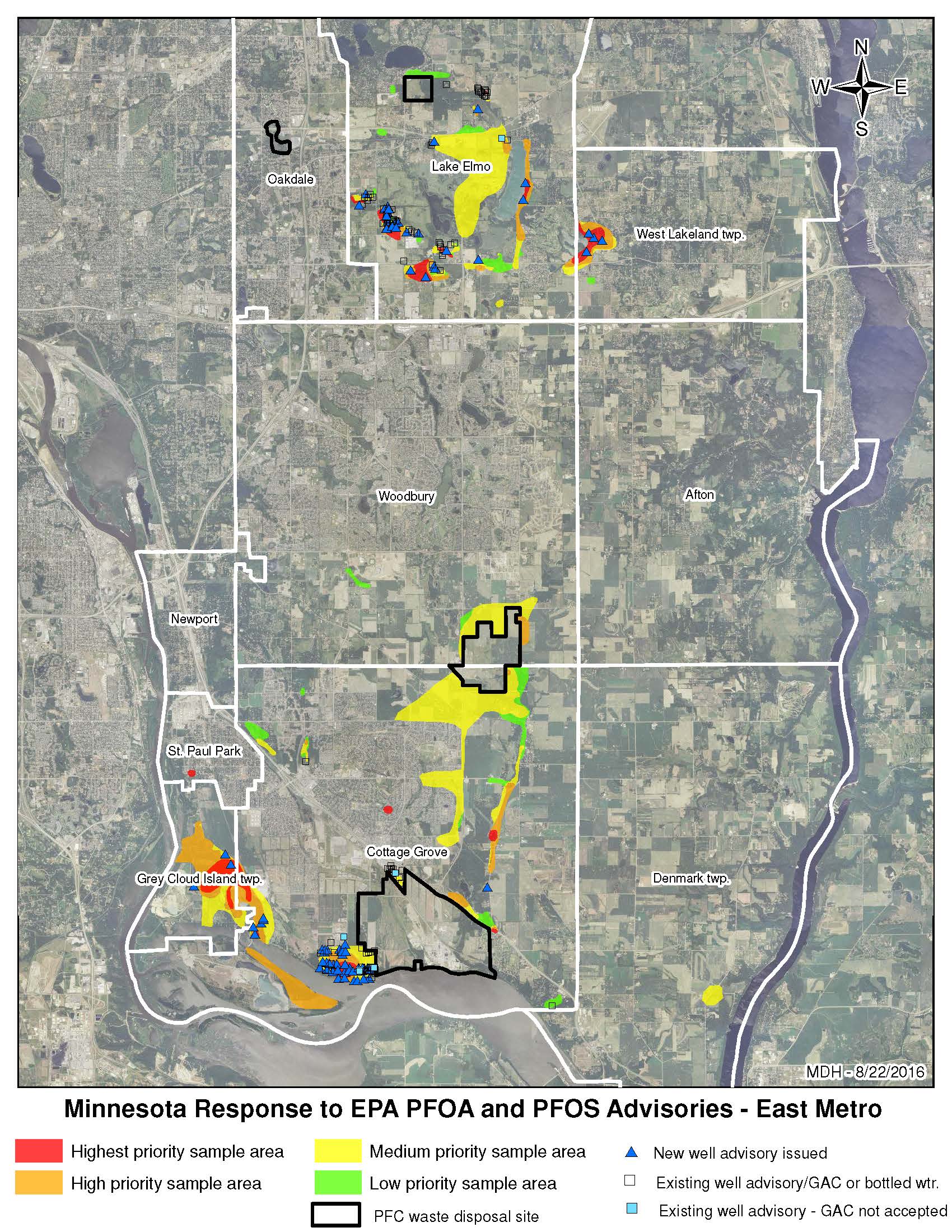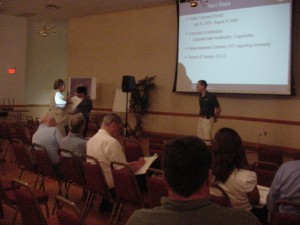Dept. of Health & 3M’s PFC/PFOA contamination
August 23rd, 2016
3M has gotten away with poisoning the water of Minnesota, and the Dept. of Health has taken some protective and/or remedial measures, but it’s not nearly enough. Isn’t it a wake-up call that we need a “Drinking Water Health Advisory” in this Land of 10,000 Lakes? Minnesota’s “Pollution Control Agency” has not been proactive on this, and we’ve known about 3M’s contamination for how long? This is why we need the EPA! The EPA is leading the charge, and Minnesota’s Department of Health (MDH), as above, has “responded” to the EPA Advisories.
80 Washington County homes will get bottled water as state reviews new pollution rules
In part:
The Dept. of Health page:
MDH Response to EPA Health Advisory for PFOS and PFOA
From the EPA’s page:
Basic Information
- Fact Sheet on PFOA and PFOS Drinking Water Health Advisories (May 2016)
- BLOG: Science Guides Public Health Protection for Drinking Water by Joel Beauvais
Technical Information
- FR Notice on the Health Advisories for PFOA and PFOS (May 25, 2016)
- 2016 PFOA Health Advisory
- 2016 PFOA Health Effects Support Document
- 2016 PFOS Health Advisory
- 2016 PFOS Health Effects Support Document
- 2016 EPA Response to Peer Review Comments
Provisional Health Advisories and Draft Health Effects Documents
Technical documents
- 2009 Provisional Health Advisory
- 2014 Draft Health Effects Document for Perfluorooctanoic Acid (PFOA)
- 2014 Draft Health Effects Document for Perfluorooctane Sulfonate (PFOS)
- Peer Reviewer Summary Report: External Peer Review of EPA’s Draft Health Effects Documents for Perfluorooctanoic Acid (PFOA) and Perfluorooctane Sulfonate (PFOS)
Peer Review
Metachem meeting in Delaware City Tuesday
July 30th, 2009
Alan Muller, Green Delaware, questioning and commenting at the meeting
Tuesday night, there was a meeting in Delaware City regarding the “Standard Chlorine of Delaware, a/k/a Metachem Superfund Site.” This meeting was to gather comments on the “OU3 Proposed Plan.”
Here’s a link to the News Journal article about it — and the full story is below:
EPA: Metachem toxins will linger
Comments must be sent in by August 14, 2009, postmarked if mailed by that date, to:
thornton.hilary@epa.gov Hilary Thornton, Mailcode 3HS23 US EPA, Region 3 1650 Arch Street Philadelphia, PA 19103
****************************************
Here are my comments, sent just now:
Now, take a few minutes and work on yours!
****************************************
The way they handle these proceedings, it’s misleading and diversionary, a false, technical compartmentalization of the problem and solutions, which leads to a preordained, incomplete, and probably ineffective “clean-up.” Part of the problem is that it’s not clear that cleaning up is a priority. My impression is that they’re just interested in “dealing with it” in some way, the CHEAPEST way, checking off the “OU3 box” and moving on.
Their plan, their PREFERRED plan, is to cover it up and move on to “OU4.” Their “Preferred Plan” is, direct from their powerpoint slide 8:
2A. Surface Cap/Institutional Controls Impermeable Surface CapInstitutional Controls
- Cap materials TBD during Remedial Design Phase
- Cap materials and thickness would vary depending on future land use
Five-Year Reviews
- Future land use must not interfere with ongoing remedies
Est. $11.5 – 18.5 Million
- Required for any Superfund Site where contaminants remain
Why look! Imagine that! This is the CHEAPEST of the options. All options are “cap” crap, with “materials TBD” and, based on prior past bad experience with DNREC’s “hare-brained” ideas (yes, that’s a direct quote)for “beneficial use” and using coal ash and sewage sludge to cap the dump next to the river:
- I asked whether they’d use coal ash in the “TBD” cover material, and they would NOT commit to rejecting coal ash.
- I asked whether they’d use sewage sludge in the “TBD” cover material, and they would NOT commit to rejecting sewage sludge.
This is where that compartmentalization becomes a problem. They said that was not an issue for “OU3” and that it would be addressed in the “design phase.” Uh-huh, and the public is involved in that exactly HOW? And hello — WHAT the impermeable surface is has much to do with the appropriateness of using an impermeable cover. Rainfall on the impermeable cover will trickle off the cover over the edge, onto and into the ground, groundwater, etc. Even if it’s asphalt, that should be considered. Isn’t the EPA is in the process of addressing coal ash, and a rule pending?
Cost… Their “preferred” option 2A costs $11.5-18 million. The others?
The other options, from their powerpoint:
2B Surface Cap/ICs, with Soil Vapor Extraction Same surface cap and ICs as mentioned in 2A, plus an in Situ SVE system:2B Surface Cap/ICs, with ISTD Same surface cap and ICs as mentioned in 2A, plus in Sit thermal Desorption:
- Est. 200-500 air extraction wells at 50′ depth
- Treat contaminated air from beneath the cap
- treat off-gas from SVE system before discharge
- Additional sampling to identify “hot spots”
- Pilot study first, to test effectiveness
- Est. $19.1-20.2 Million
- Est. 2,800 heater and 1,400 heated vapor extraction wells, 8-12′ apart through 330,000 sq. ft. area
- Additional sampling to identify “hot spots” within 10′ of barrier wall
- Pilot study first, to test effectiveness
- Est. $92.8-99.8 Million
Let’s see… $11.5-18.5 v. $19.1-20-2 & $92.8-99.8. Doesnt’ take a rocket scientist to see that the cheapest “option” is “preferred,” and since when is cost the primary driver? Is this an indication of how they value those living here, drinking the water, breathing the air?
Oh, and did I mention they admitted, finally, that the contamination goes down at least 140 feet! That’s something they haven’t wanted to talk about before.
These options are the only ones looked at, the only ones that are under consideration.
CONSIDER THIS: One other option I want them to consider is to dig up part of the site, the cleaner part, and put a liner down there and take the contaminated dirt from the rest of the site and bury it there with the solid multi-layer liner, and then cover it.
Here’s an example of that in Minnesota, showing that it can and should be done. This is a scenario where it’s been sitting there since before the mid 70s, it has contaminated ground water in Lake Elmo and Oakdale, Minnesota. They’re using three layers of liner over packed clay and another three layers of plastic, plus sand with a collection and draingae system. In the Metachem case, they know groundwater is contaminated, that it’s seeping down, so what, short of this, will stop it? Take a look — Tom Meersman did a very good job on this:
History-making landfill do-over in Washington County
SD’s Sen. Thune sucks up to Big Stone II
February 3rd, 2009
Horses Ass Award for South Dakota’s Senator John Thune.
Has he no shame? Sen. John Thune fired off this letter to the EPA when it filed objections to the Big Stone II air permit. Whatever is he thinking? That the regulations don’t apply to his pet project, despite the obvious emissions problems?
Here’s the letter:
It has recently come to my attention that the Environmental Protection Agency (EPA) has issued some objections regarding the South Dakota Department of Environment and Natural Resources (DENR) desire to renew the operating permit for the existing Big Stone Power Plant in South Dakota. As a strong proponent of expanding our commitment to addressing our nation’s energy challenges, I am writing to inquire about your Agency’s recent action, as well as how this objection impacts the Big Stone II project.
As you know, the United States is the world’s largest electricity consumer and is expected to remain that way for decades to come. In the Upper Midwest, experts predict several thousand megawatts of generation capacity are needed to meet our region’s growing energy demands. In responding to this challenge, five electric utilities have proposed building a 500-580-megawatt, coal-fired electric generation plant. The new facility would be built next to the existing 450-megawatt Big Stone Power Plant, located near Big Stone City, South Dakota. Four of these partners (Otter Tail Power Company, Heartland Consumers Power District, Montana-Dakota Utilities Company and Missouri River Energy Services) provide electricity to thousands of my constituents throughout South Dakota, and more than one million people when you total their services to individuals and businesses in four other states.
While the addition of Big Stone II will more than double the plant’s generation capacity, it will also utilize new technologies so that emissions of sulfur dioxide, nitrogen oxides and mercury from the two plants will be cleaner than the current, single plant. Big Stone II is also expected to emit 20 percent less carbon dioxide than existing coal-fired power plants in the region. Since President Obama indicated his readiness to “invest in low emissions coal plants” within his New Energy for America plan, I trust the Administration will support the efforts of these dedicated individuals who have committed their work, time and money on this project to ensure the region will have safe, reliable and affordable energy in the future.
This project is also crucial to our region’s increased commitment to wind energy development. As a United States Senator, I have endeavored to promote the advancement of wind energy in order to grow South Dakota’s economy and help meet our nation’s growing energy demands. One significant impediment to increasing wind energy production is the lack of transmission lines available to transfer this harnessed product to markets in need. Transmission upgrades that coincide with the construction of Big Stone II will also provide opportunities for the expansion of renewable wind energy in the region.
While I appreciate that permitting procedures under the Clean Air Act can be very complex, I understand that the South Dakota DENR has 90 days to submit a revised permit that meets the objections raised by your Agency. I am confident that the participating utilities and DENR will provide sufficient adjustments to the permit so the project is completed in an environmentally responsible manner that provides the electrical power essential to the region. Despite the claims by some advocacy groups, I sincerely hope the last-minute list of objections by EPA is not an attempt to derail this important and needed project.
I believe there is great potential in this undertaking by the five participating utilities. I look forward to hearing about your Agency’s role in moving this project forward, as it is essential to promoting economic growth and meeting the region’s energy demands, including expanded wind generation.
Kindest regards,
John Thune
United States Senator
EPA objects to Big Stone II air permit
January 23rd, 2009
EEEEEEE-HAAAAAAAA! A big stake in its slimy little heart…
Hot off the press from Sierra Club and Clean Water Action, who have been working tirelessly against Otter Tail Power’s Big Stone II coal plant, the Big Stone II air permit is upende
Here’s their press release in toto:
FOR IMMEDIATE RELEASE:
CONTACT:
Virginia Cramer, Sierra Club 804-519-8449
Darrell Gerber, Clean Water Action 612-802-5372Date: January 23, 2009
Big Stone II Sent Back to the Drawing Board
U.S. Environmental Protection Agency Concerned About Pollution, Global WarmingWashington, DC – Less than three days after the Bush Administration left office, the Environmental Protection Agency (EPA) has overturned the State of South Dakota’s approval of the massive Big Stone II coal-fired power plant. The EPA’s decision comes after the state failed to require state-of-the-art pollution controls for the coal plant that would address concerns about harmful soot, smog and global warming pollution.
“This is a great day not only for clean energy and people’s health, it’s a victory for the rule of law,” said Bruce Nilles, Director of the Sierra Club’s Move Beyond Coal Campaign. “EPA is signaling that it is back to enforcing longstanding legal requirements fairly and consistently nationwide,” added Nilles.
As the first major coal plant decision by the EPA since President Obama took office, this decision signals that the dozens of other coal plant proposals currently in permitting processes nationwide will face a new level of federal scrutiny. Sierra Club and Clean Water Action have been working to stop the Big Stone II project and ramp up clean energy investments in for more than three years.
“Today EPA took the first step toward restoring science and integrity to its work and recognizing the very real need to reduce air pollution from coal-fired power plants,” said Darrell Gerber, Clean Water Action Program Coordinator. “Downwind residents and the region’s natural resources will be better protected.”
This decision likely spells the end of Otter Tail Power’s Big Stone II coal plant. While for the past eight years the Bush Administration has refused to regulate global warming pollution, even after being ordered to do so by the US Supreme Court, President Obama has pledged that the US will cut global warming pollution and do its part to avoid the worst consequences of climate change. With coal-fired power plants accounting for almost 30% of our nation’s carbon dioxide emissions, burning less coal and investing in clean energy such as wind and solar instead is a common sense approach to helping meet global warming pollution reduction goals. The proposed Big Stone II 500-megawatt coal plant would have emitted more than 4 million tons of global pollution annually.
At a minimum, Otter Tail Power will have to go back to the drawing board and redesign the project to incorporate the best and maximum available control technology for pollution like soot and smog. Sierra Club and Clean Water Action will be pushing for EPA to set limits also for carbon dioxide, the main contributor to global warming.
“Otter Tail Power will now have to be responsible for the cost of its pollution,” said Nilles. “We hope that this increasing cost of coal will encourage Otter Tail Power, along with Governors Pawlenty and Rounds, to harness the clean and affordable wind resources available in the region. Minnesota and South Dakota should be leaders on the path to renewable energy independence, not laggards proposing 19th century coal plants.”
###
Now, can we get them to end Excelsior Energy’s Mesaba Project?
TVA ash spill in NYT
December 26th, 2008
Clean coal? Ask anyone near TVA’s Kingston Plant… THERE IS NO SUCH THING AS CLEAN COAL!
Yesterday’s New York Times had the TVA ash spill front and center:
Clean up is going to be a long, slow, costly process, and can it even be cleaned up?
And here’s a review of the “Issues of Hazards” raised in the article:
Similarly, a 2006 study by the federally chartered National Research Council found that these coal-burning byproducts “often contain a mixture of metals and other constituents in sufficient quantities that they may pose public health and environmental concerns if improperly managed.” The study said “risks to human health and ecosystems” might occur when these contaminants entered drinking water supplies or surface water bodies.
In 2000, the Environmental Protection Agency proposed stricter federal controls of coal ash, but backed away in the face of fierce opposition from utilities, the coal industry, and Clinton administration officials. At the time, the Edison Electric Institute, an association of power utilities, estimated that the industry would have to spend up to $5 billion in additional cleanup costs if the substance were declared hazardous. Since then, environmentalists have urged tighter federal standards, and the E.P.A. is reconsidering its decision not to classify the waste as hazardous.
And regarding coal ash dump pollution:
Another 2007 E.P.A. report said that over about a decade, 67 towns in 26 states had their groundwater contaminated by heavy metals from such dumps.





